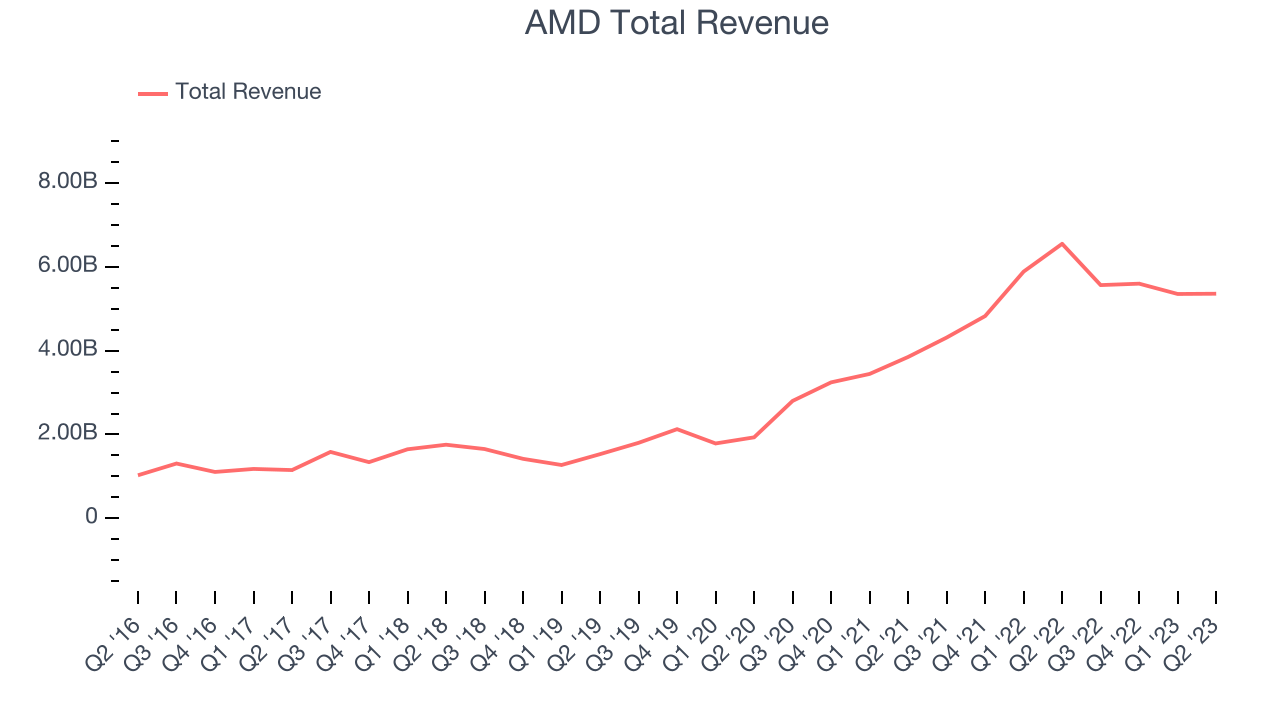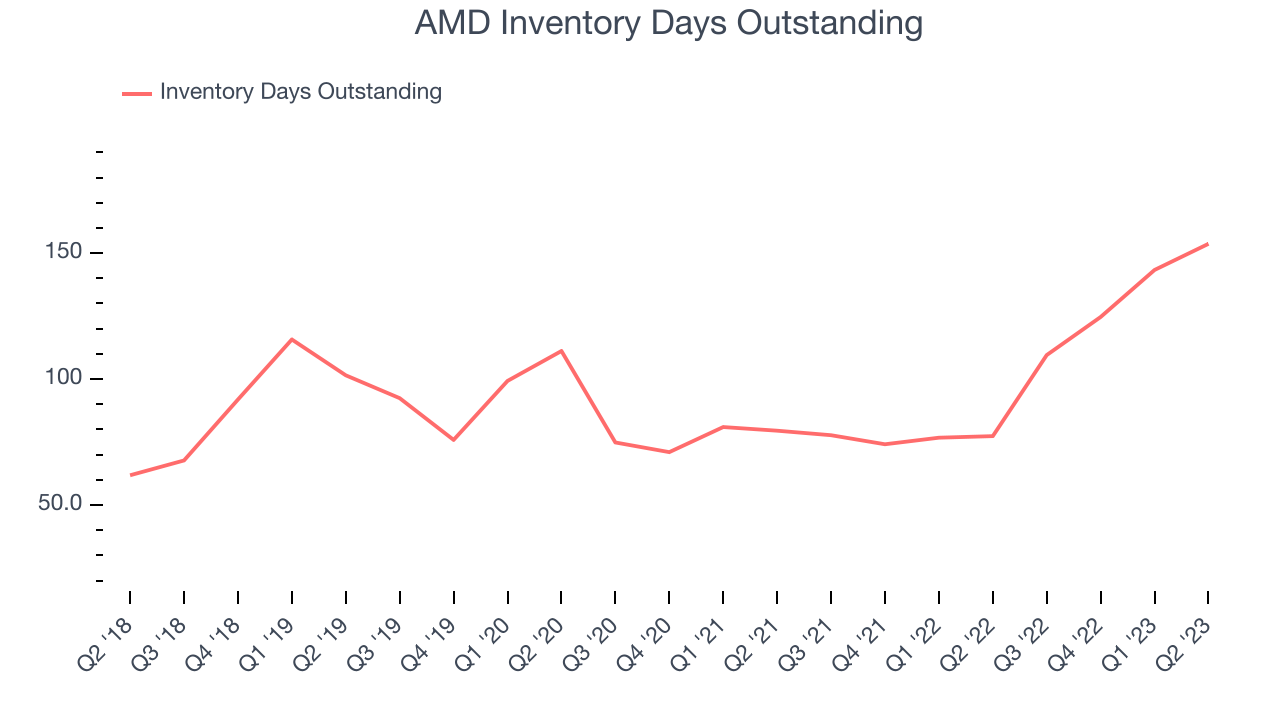Computer processor maker AMD (NASDAQ:AMD) reported results in line with analysts' expectations in Q2 FY2023, with revenue down 18.2% year on year to $5.36 billion. However, next quarter's revenue guidance of $5.7 billion was less impressive, coming in 2.57% below analysts' estimates. AMD made a GAAP profit of $27 million, down from its profit of $447 million in the same quarter last year.
Is now the time to buy AMD? Find out by accessing our full research report free of charge.
AMD (AMD) Q2 FY2023 Highlights:
- Revenue: $5.36 billion vs analyst estimates of $5.32 billion (small beat)
- EPS (non-GAAP): $0.58 vs analyst estimates of $0.57 (1.03% beat)
- Revenue Guidance for Q3 2023 is $5.7 billion at the midpoint, below analyst estimates of $5.85 billion
- Free Cash Flow of $254 million, down 22.6% from the previous quarter
- Inventory Days Outstanding: 154, up from 143 in the previous quarter
- Gross Margin (GAAP): 49.5%, down from 52.4% in the same quarter last year
“We delivered strong results in the second quarter as 4th Gen EPYC and Ryzen 7000 processors ramped significantly,” said AMD Chair and CEO Dr. Lisa Su.
Founded in 1969 by a group of former Fairchild semiconductor executives led by Jerry Sanders, Advanced Micro Devices or AMD (NASDAQ:AMD) is one of the leading designers of computer processors and graphics chips used in PCs and data centers.
The biggest demand drivers for processors (CPUs) and graphics chips at the moment are secular trends related to 5G and Internet of Things, autonomous driving, and high performance computing in the data center space, specifically around AI and machine learning. Like all semiconductor companies, digital chip makers exhibit a degree of cyclicality, driven by supply and demand imbalances and exposure to PC and Smartphone product cycles.
Sales Growth
AMD's revenue growth over the last three years has been impressive, averaging 46.8% annually. But as you can see below, its revenue declined from $6.55 billion in the same quarter last year to $5.36 billion. Semiconductors are a cyclical industry, and long-term investors should be prepared for periods of high growth followed by periods of revenue contractions (which can sometimes offer opportune times to buy).

Even though AMD surpassed analysts' revenue estimates, this was a slow quarter for the company as its revenue dropped 18.2% year on year. This could mean that the current downcycle is deepening.
While most things went back to how they were before the pandemic, a few consumer habits fundamentally changed. One founder-led company is benefiting massively from this shift and is set to beat the market for years to come. The business has grown astonishingly fast, with 40%+ free cash flow margins, and its fundamentals are undoubtedly best-in-class. Still, its total addressable market is so big that the company has room to grow many times in size. You can find it on our platform for free.
Product Demand & Outstanding Inventory
Days Inventory Outstanding (DIO) is an important metric for chipmakers, as it reflects a business' capital intensity and the cyclical nature of semiconductor supply and demand. In a tight supply environment, inventories tend to be stable, allowing chipmakers to exert pricing power. Steadily increasing DIO can be a warning sign that demand is weak, and if inventories continue to rise, the company may have to downsize production.

This quarter, AMD's DIO came in at 154, which is 59 days above its five-year average, suggesting that the company's inventory has grown to higher levels than we've seen in the past.
Key Takeaways from AMD's Q2 Results
Sporting a market capitalization of $184 billion, more than $6.29 billion in cash on hand, and positive free cash flow over the last 12 months, we believe that AMD is attractively positioned to invest in growth.
It was comforting to see that AMD topped analysts' earnings expectations this quarter, even if just narrowly. Additionally, management called out that "Data Center and Client segment revenues to each grow by a double-digit percentage sequentially driven by increasing demand for our EPYC and Ryzen processors", which was bullish. These really stood out as positives in these results. On the other hand, its underwhelming total revenue guidance for next quarter was disappointing, driven by "Gaming and Embedded segment declines". However, it seems like the market is putting more weight on the Data Center and Client segments that are performing better. Overall, the results were mixed but solid in the face of fairly low expectations. The stock is up 3.5% after reporting and currently trades at $121.78 per share.
AMD may have had a tough quarter, but does that actually create an opportunity to invest right now? When making that decision, it's important to consider its valuation, business qualities, as well as what has happened in the latest quarter. We cover that in our actionable full research report which you can read here, it's free.
One way to find opportunities in the market is to watch for generational shifts in the economy. Almost every company is slowly finding itself becoming a technology company and facing cybersecurity risks and as a result, the demand for cloud-native cybersecurity is skyrocketing. This company is leading a massive technological shift in the industry and with revenue growth of 50% year on year and best-in-class SaaS metrics it should definitely be on your radar.
The author has no position in any of the stocks mentioned in this report.
